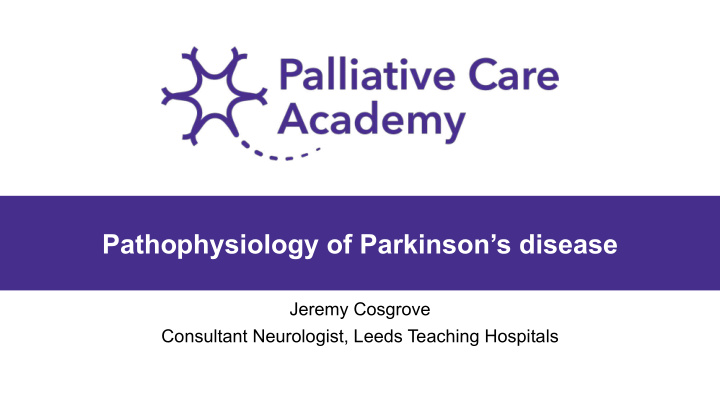



Pathophysiology of Parkinson’s disease Jeremy Cosgrove Consultant Neurologist, Leeds Teaching Hospitals
Outline • Who gets Parkinson’s and why? • What is Parkinson’s? • How can we link changes in the brain with the symptoms of Parkinson’s? • What is Parkinson’s disease dementia and how is that different to dementia with Lewy bodies?
Epidemiology Population Incidence Prevalence England 55,997,686 15,465 121,927 UK 66,465,641 18,461 145,519 Population Incidence Prevalence 2025 68,929,547 21,451 168,582 https://www.parkinsons.org.uk/professionals/resources/inci dence-and-prevalence-parkinsons-uk-report 2065 76,898,078 32,303 256,609
Epidemiology • 0.2% of all UK population • 1% of 65 year olds • 4% of 80 year olds • 22 people in a GP practice of 10,000
Risk factors • Advancing age • Male > female 3:2 • Caucasians > Asians and Africans • Family history Kalia and Lang, 2015
Deng et al, 2018
What is Parkinson’s? - Clinical Diagnosis ‘Easy’ Prodrome – before diagnosis ‘Hard’ Kalia and Lang, 2015
Mechanisms causing cell dysfunction Pathological hallmarks: 1) Early degeneration and death of dopaminergic neurons within the substantia nigra pars compacta of the basal ganglia 2) α-syn - Lewy body (cell body) and Lewy neurite (axons)
Mechanisms causing cell dysfunction Irwin et al., 2013 Dexter & Jenner, 2013
What is Parkinson’s - Pathological • Stage 1: Medulla • Stage 2: Pontine tegmentum • Stage 3: Midbrain • Stage 4: Prosencephalon and mesocortex • Stage 5 & 6: Neocortex Braak et al, 2003
“Gut-brain axis” Houser & Tansey, 2017
Neurotransmitter pathways Dopaminergic Noradrenergic Serotonergic Cholinergic Haliday at al., 2014
Linking pathology with symptoms Parietal cortex Mild cognitive impairment (MCI) Motor symptoms Frontal Dementia cortex Hallucinations Occipital cortex Prodrome ? Cerebellum Mid-brain Constipation? ? RBD, EDS, Low mood Pons Increased heart rate? ? Medulla Loss of smell Autonomic changes?
Age, hallucination and dementia Reid et al., 2011 Hely et al., 2008
Events heralding the palliative stage Residen&al)care) Visual)hallucina&ons) Falls) Cogni&ve)impairment) Number)of)cases) Age)at)onset) Kempster et al., 2010
Dual syndrome hypothesis Kehagia et al. 2013 Williams-Gray et al., 2009
Complexity of cognitive change in PD Aarsland et al., 2017 Cosgrove et al., 2015
What is PDD and what is DLB? PDD DLB • Impairment in more than one cognitive domain • Representing a decline from premorbid level • Deficits severe enough to impair daily life (social, occupational, or personal care), independent of the impairment ascribable to motor or autonomic symptoms Emre et al., 2007 https://www.lbda.org/go/lbd-spectrum
Pathological spectrum of PDD and DLB Berg et al,. 2014
Conclusions • Alpha-syn is the major pathological driver of PD • Braak model of caudo-rostral spread can link pathology to symptoms • Neurotransmitter dysfunction is common in PD and relates to non- motor symptoms • DLB and PDD are similar entities clinically and part of a disease spectrum
References: Kalia LV, Lang AE. Parkinson's disease. Lancet. 2015 Aug 29;386(9996):896-912. Hely MA, Reid WG, Adena MA, Halliday GM, Morris JG. The Sydney multicenter study of Parkinson's disease: the inevitability of dementia at 20 years. Movement disorders : official journal of the Movement Disorder Society. 2008;23(6):837-844. Deng H ,Wang P, Jankovic J. The genetics of Parkinson disease. Ageing Research Reviews. 2018 42: 72-85 Kempster P, O'Sullivan S, Holton J, Revesz T, Lees A. Relationships between age and late progression of Parkinson's disease: a clinico-pathological study. Brain. 2010;133(6):1755- Irwin D, Lee V, Trojanowski J. Parkinson's disease dementia: convergence of α-synuclein, 1762. tau and amyloid-β pathologies. Nature Reviews Neuroscience. 2013;14(9):626-636 Williams-Gray CH, Evans JR, Goris A, et al. The distinct cognitive syndromes of Parkinson's Dexter DT & Jenner P. Parkinson disease: from pathology to molecular disease disease: 5 year follow-up of the CamPaIGN cohort. Brain. 2009;132(Pt 11):2958-2969. mechanisms. Free Radical Biology and Medicine. 2013 62: 132-44 Kehagia AA, Barker RA, Robbins TW. Cognitive impairment in Parkinson's disease: the dual Braak H, Del Tredici K, Rüb U, de Vos R, Jansen Steur E, Braak E. Staging of brain syndrome hypothesis. Neuro-degenerative diseases. 2013;11(2):79-92. pathology related to sporadic Parkinson's disease. Neurobiology of Aging. 2003;24(2):197- 211 Aarsland D, Creese B, Politis M, et al. Cognitive decline in Parkinson disease. Nature reviews Neurology. 2017;13(4):217-231. Houser MC & Tansey MG. The gut-brain axis: is intestinal inflammation a silent driver of Parkinson’s disease pathogenesis? npj Parkinson’s Disease (2017)3:3 ; doi:10.1038/s41531- 016-0002-0 Cosgrove J, Alty JE, Jamieson S. Cognitive impairment in Parkinson's disease. Postgraduate medical journal. 2015;91(1074):212-220. Halliday GM, Leverenz JB, Schneider JS, Adler CH. The neurobiological basis of cognitive impairment in Parkinson's disease. Movement disorders 2014;29(5):634-650. Emre M, Aarsland D, Brown R, et al. Clinical diagnostic criteria for dementia associated with Parkinson's disease. Movement disorders 2007;22(12):1689-1707; quiz 1837. Reid WG, Hely MA, Morris JG, Loy C, Halliday GM. Dementia in Parkinson's disease: a 20- year neuropsychological study (Sydney Multicentre Study). Journal of neurology, neurosurgery, and psychiatry. 2011;82(9):1033-1037. Berg D et al. Time to Redefine PD? Introductory Statement of the MDS Task Force on the Definition of Parkinson's Disease. Movement disorders . 2014: 29(4) DOI: 10.1002/mds.25844
Recommend
More recommend